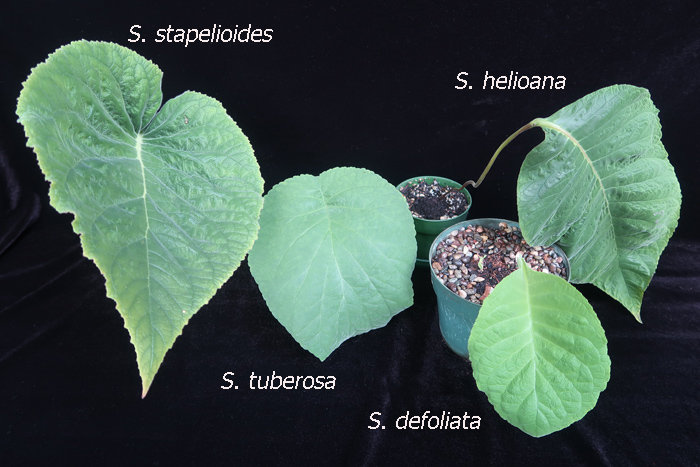Here is a comparison among the four species.
| |
S. defoliata |
S. helioana |
S. stapelioides |
S. tuberosa |
| Growth habit |
One or more short (less than 2 cm) single-leaved stems,
giving the appearance of leaves growing directly from tuber |
One or more (usually) single-leaved wiry stems (4-10 cm long),
giving the appearance of petioles growing directly from tuber |
One or more (usually) single-leaved wiry stems (4-10 cm long),
giving the appearance of petioles growing directly from tuber |
Multiply branched stems, each branch ending in one or two leaves. |
| Leaf shape (for unifoliate habit) |
Elliptical, up to 24 inches long, length-to-width usually less than 2:1 |
1-8 inches long, length-to-width is about 3:1 |
4-10 inches long, length-to-width is about 1.5 |
2-6 inches long, almost round, length-to-width would be about 1
were it not for the relatively narrow tip |
| Leaf margin |
Smooth |
Almost smooth, slight indentations |
Pronounced indentations |
Almost smooth, slight indentations |
| Leaf back |
Green (no trace of red except in young leaf, when the leaf top
can be reddish too) |
Reddish, secondary veins in low relief |
Reddish, secondary veins in high relief |
Green, secondary veins in moderate relief |
| Tuber |
Disk-shaped, convex, can have stubs from previous years' stems |
Disk-shaped, convex |
Disk-shaped, convex |
Like a caudex, usually with multiple branches |
| Flowering season |
Winter |
Winter |
Winter |
Summer |
| Inflorescence |
Raceme, emerging directly from tuber, flowers held more or
less horizontally |
Cyme with peduncle, emerging directly from tuber, flowers pendant |
Cyme with peduncle, emerging directly from tuber, flowers pendant |
Raceme, directly from tuber or above-ground branches of tuber |
| Corolla shape and color |
Tubular, red with no conspicuous markings |
Tubular, red with white throat |
Trumpet-shaped, heavily spotted |
Tubular, orange-red or red |
| Calyx |
Dark red |
Reddish, short |
During development, red and completely encloseding bud.
Later, with reddish tips on calyx lobes. |
Short, red with green tips on lobes. |
